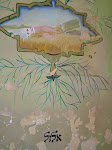
In an area of paint loss located on the original plaster just above the decorative border on the west wall, between Shivat and Tevet, revealed writing in what appears to be pencil. Initially the letters were only partially visible, but as they seemed to be of importance we went ahead and lifted the adjacent paint layers. This revealed more letters...with the help of the the shul members, Miriam, Elissa, Josh and Jonathan, the meaning of the words was clarified, "Leave the whole bench (area) free".
Di=The
Gantzeh= whole thing, entire
Bank= bank of benches
Frei= free
There are still some letters that remain uncovered. Who knows what new information will be gained when they are revealed. One explanation of, "leave the benches free" could be to keep the benches out of the area in order to have space to paint the mazels. Another explanation is to keep the lower part of the wall open for the the intended decoration to be painted. These words represent a moment captured in time when the original decoration was was being painted. How exciting!
Last week we were able to take measurements of the moisture content in all of the mazels and the areas in between. The specialized equipment was loaned to us by our colleague and great supporter of the Stanton Street Synagogue project, Norman Weiss. It was found that areas with the most visible damage indeed have moisture problems. We are on the ball, and with time, research and further collaboration with specialists, we will know where the problems stem from and how they can be mitigated. We want to keep the great momentum going...
We are well on our way to finishing the stabilization of all of the mazels. Amazingly, we are able to carry out more consolidation than anticipated. This is great for the safety of the paintings as we wait for the next phase to begin...
01.jpg)